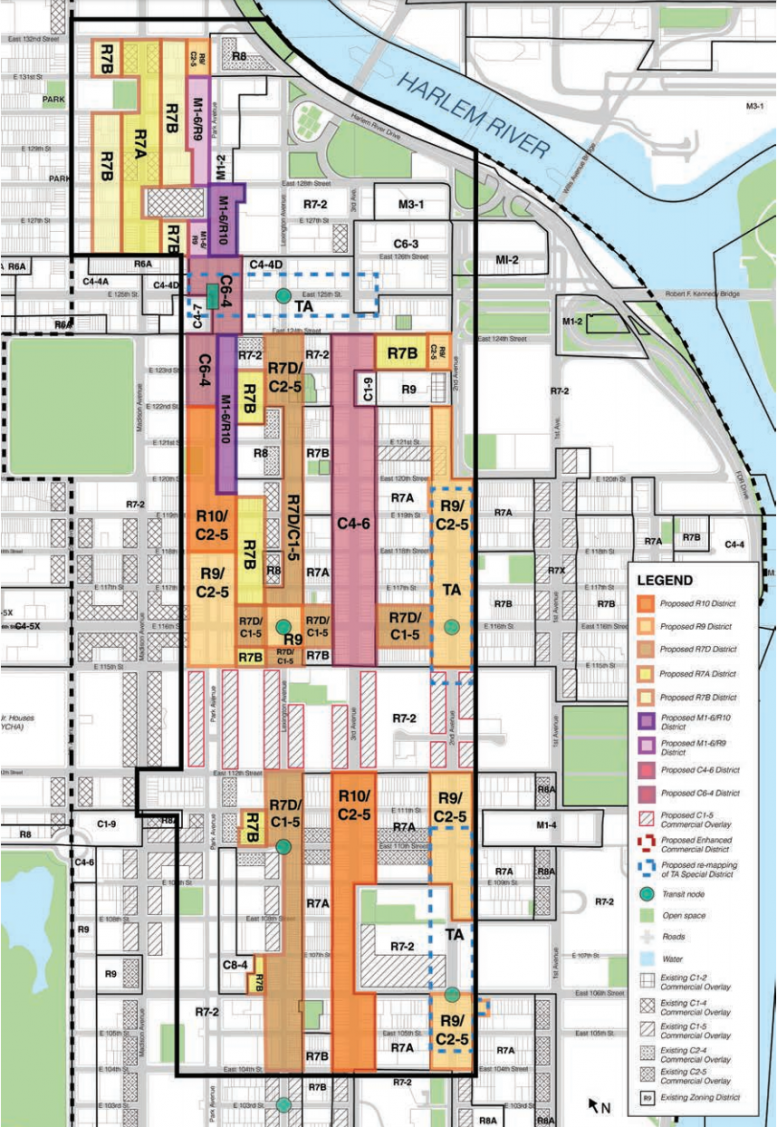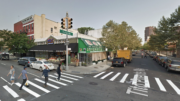When city planners unveiled the new zoning for East Harlem at a community board meeting last month, neighbors wanted to know how many new apartments would grow, and how many people could potentially be displaced. Now the city has revealed estimates of how the rezoning would reshape the upper Manhattan neighborhood in a new set of zoning documents.
The plans offer two sets of data. The first analyzes how much residential space would sprout from 69 development sites throughout the neighborhood. Then the second set of estimates includes the number of new apartments constructed if the city chooses to build on a city-owned, vacant block between Park Avenue, Madison Avenue, East 111th and East 112th Streets.
The East 111th Street site was once home to brownstones and row houses, much like all the other blocks around it that now host massive public housing projects. Under the guise of the federal slum clearance program, the New York City Housing Authority razed 171 acres of homes in the 1930s and ’40s and erected brick apartment towers in their place. The empty, 76,600-square-foot block on East 111th Street was cleared but never developed. It now features a collection of community gardens and a baseball field.
Without the East 111th Street site, planners expect the rezoning to generate 3,500 apartments and draw 8,420 new residents. Future developments would also add 110,133 square feet of retail and 138,328 square feet of office space. New construction would boost community facility space by 98,922 square feet and industrial space by 132,394 square feet. The neighborhood would lose 33,000 square feet of hotels and 10,600 square feet of auto-related businesses.
Since the lot on East 111th Street would become a massive, mixed-use development, development there boosts the numbers quite a bit. Those estimates call for 4,162 new apartments, 140,133 square feet of retail and 138,328 square feet of office space. They also detail plans for 158,922 square feet of new community facilities and 132,394 square feet of industrial space. Roughly 10,000 new residents would move into the neighborhood.
The documents don’t shed much light on how many people might be displaced by new development. They only note that the rezoning could displace “more than 500 residents.”
Any new development that happens on rezoned blocks will be subject to the mayor’s new Mandatory Inclusionary Housing Policy program. MIH requires builders to set aside 25 to 30 percent of apartments in a new building as below-market-rate housing.The City Council and and the council member who represents East Harlem, Speaker Melissa Mark-Viverito, will ultimately decide how much affordable housing developers will have to build and at what income levels. Depending on which affordability option the council chooses, income ranges for affordable units could be as low as 40 percent of the Area Median Income ($36,240 for a family of four) or as high as 130 percent AMI ($117,780 for a four-person household).
The East Harlem rezoning still has several months of public approvals until it can become official. The next step in the process is a public scoping meeting on December 15 at the Silberman School of Social Work at Hunter College, at 2180 Third Avenue. The Department of City Planning will offer two sessions at 2 and 6 p.m., where members of the public and local stakeholders can testify about the rezoning.
Update: On December 9, the Department of City Planning posted a note about how many tenants may be displaced on the scoping page for the East Harlem rezoning. The original Draft Scope of Work predicted that at least 500 tenants would be displaced. “We do not anticipate that 500 residents will be directly displaced as a result of the proposal,” the note reads. “The original Draft Scope of Work erroneously assumed that an existing residential development could be demolished and redeveloped as a result of being rezoned. In fact, the residential development is actually located outside of the boundaries of the proposed rezoning area and would be unaffected by the rezoning.”
Subscribe to the YIMBY newsletter for weekly updates on New York’s top projects
Subscribe to YIMBY’s daily e-mail
Follow YIMBYgram for real-time photo updates
Like YIMBY on Facebook
Follow YIMBY’s Twitter for the latest in YIMBYnews






More of the same. The people currently living in this new zone will no longer be able to afford to live there. Damn. Damn. We lived there during the hard times and now when there is no more space for those who can afford to move into the neighborhood and have no where else to live we have to leave. That lot on 111th street has been there for years and years. There is no difference between what is happening to us than what happened to the Indians. Those with the least money are moved to accommodate those with more money.
You do know that without additional housing capacity demand will eclipse supply and housing prices will increase significantly faster than it would otherwise? Each community needs to build more housing.
An increase in capacity means that prices won’t inflate due to not meeting demand.
You want increased capacity so people who live there already won’t get priced out.
If the proposal materialize without no matter, matching material from people and rezoning.
If money wasn’t god, they could build housing that the poor could afford. Market economics puts money before people. I’m not sure the economic system could work any other way, which suggests that something other than economics is needed.
Send me an application for appartmen.